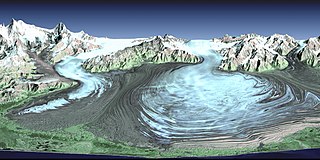 W
WAgassiz Glacier is a valley glacier in the Saint Elias Mountains in southern Alaska (USA) and to a lesser extent on to Canadian territory.
 W
WThe Aialik Glacier is a glacier in the Kenai Peninsula Borough of Alaska. It drains into Aialik Bay. Part of Kenai Fjords National Park, it drains the Harding Icefield. Aialik Glacier, a little over 15 miles from Seward, is the largest glacier in Aialik Bay, located in Kenai Fjords National Park. While fairly stable, the glacier calves most actively in May and June.
 W
WAlsek Glacier is a 24-kilometer (15 mi) long glacier in Glacier Bay National Park in the Panhandle of Alaska (USA). The name Alsek is of Tlingit origin and may mean "place where people rest". Glacier was named in 1901 by U.S. Navy Lieutenant Commander Moser, commander of the U.S. Bureau of Fisheries steamer USS Albatross.
 W
WAurora Glacier is a 4-mile (6.4 km) long glacier in the U.S. state of Alaska. It heads east of July Fourth Mountain and trends northwest to an icefield between the heads of Reid and Brady Glaciers in Glacier Bay National Park and Preserve, 61 miles (98 km) northwest of Hoonah.
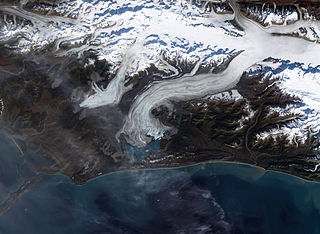 W
WBering Glacier is a glacier in the U.S. state of Alaska. It currently terminates in Vitus Lake south of Alaska's Wrangell-St. Elias National Park, about 10 km (6.2 mi) from the Gulf of Alaska. Combined with the Bagley Icefield, where the snow that feeds the glacier accumulates, the Bering is the largest glacier in North America. The glacier is named after Vitus Bering.
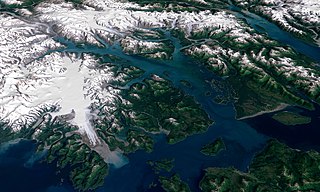 W
WBrady Glacier is a 24-mile-long (39 km) glacier located in Glacier Bay National Park and Preserve in the U.S. state of Alaska. It begins at 58°40′N 136°47′W and trends south to Taylor Bay, 46 miles (74 km) northwest of Hoonah. It was named by the U.S. Coast and Geodetic Survey for missionary and later governor Rev. John Green Brady.
 W
WBuckskin Glacier is a glacier in Denali National Park and Preserve in the U.S. state of Alaska. The glacier originates on the east side of The Moose's Tooth, flowing east, then southeast, for 14 miles (23 km) before giving rise to the Hidden River.
 W
WCasement Glacier is a 14 miles (23 km) long glacier in the Glacier Bay National Park in Alaska (USA). It was named in 1890 by Harry Fielding Reid in honour of R.L. Casement, member of Reid expedition on SS George W. Elder. Back then Casement Glacier was first north tributary of Muir Glacier and not yet completely detached one.
 W
WThe Castner Glacier lies on the southern flank of the Delta Range, an eastern section of the Alaska Range. The glacier begins on the peak White Princess and continues to the head of Castner Creek, northwest of Paxson, Alaska. The glacier was named by Edwin Forbes Glenn in 1898 after Joseph Compton Castner.
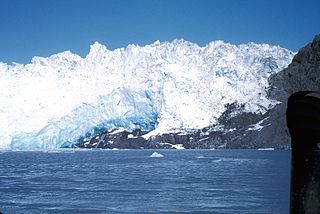 W
WChenega Glacier is a tidewater glacier located in Prince William Sound and on the Kenai Peninsula in the U.S. state of Alaska.
 W
WClark Glacier is an 8-mile (13 km) long glacier located on Mount Abbe in Glacier Bay National Park and Preserve in the U.S. state of Alaska. It leads northwest to its 1961 terminus at the head of Johns Hopkins Inlet, 78 mi (126 km) northwest of Hoonah, Alaska. It was named by W. O. Field and W. S. Cooper in 1936 for Johns Hopkins University professor of geology William Bullock Clark (1860–1917).
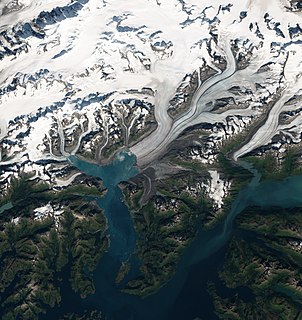 W
WThe Columbia Glacier is a glacier in Prince William Sound on the south coast of the U.S. state of Alaska, is one of the fastest moving glaciers in the world, and has been retreating since the early 1980s. It was named after Columbia University, one of several glaciers in the area named for elite U.S. colleges by the Harriman Alaska Expedition in 1899. The head of the main branch of the glacier originates at the saddle between Mount Witherspoon and Mount Einstein.
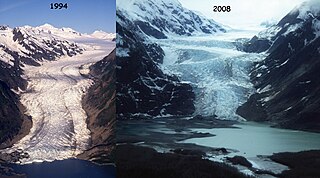 W
WThe Davidson Glacier is a large valley glacier near Haines, Alaska that finds its source in the Chilkat Range.
 W
WDouble Glacier is an 11 mi (18 km) long glacier in the Kenai Peninsula Borough of Alaska, located 47 mi (76 km) west-northwest of Kenai. As its name suggests, Double Glacier is divided into two lobes.
 W
WFairweather Glacier is a 19-mile-long (31 km) glacier in Glacier Bay National Park and Preserve in the U.S. state of Alaska. It begins on the west slope of Mount Salisbury and continues west to its 1961 terminus 0.2 miles east of Cape Fairweather, 100 miles (161 km) northwest of Hoonah.
 W
WFourpeaked Glacier is a calving glacier covering much of Fourpeaked Mountain, also known as Fourpeaked Volcano.
 W
WGuyot Glacier is a 34-mile (55 km) long and 8-mile (13 km) wide glacier located in the east end of the Robinson Mountains in the U.S. state of Alaska. It begins 5.6 mi (9.0 km) north of Yaga Peak and heads east-southeast to Icy Bay, south of the Guyot Hills and 73 miles (117 km) northwest of Yakutat. It borders Yahtse Glacier on the northeast. The glacier was named by the New York Times expedition of 1886 for Arnold Henry Guyot.
 W
WHarper Glacier is a glacier in Denali National Park and Preserve in the U.S. state of Alaska. The glacier originates on Denali at more than 19,000 feet (5,800 m) between Denali's North Peak and South Peak, falling to the northeast between the Karsten Ridge and the Taylor Spur. From about 12,000 feet (3,700 m) it falls between Pioneer Ridge and Karpe Ridge in the Great Icefall down to the Lower Icefall to become Muldrow Glacier. In 1913, the glacier was named by Hudson Stuck after Walter Harper, a Koyukon mountaineer and the first man to reach the summit of Denali.
 W
WThe Harvard Glacier is a large tidewater glacier in the Alaska's Prince William Sound. The glacier has a 1.5-mile (2 km) wide face where it calves into the College Fjord. It is 300 ft thick and covers 120,000 acres of Chugach National Forest. The Harvard Glacier is the second largest glacier in the Prince William Sound, after the Columbia Glacier. It is a popular destination of cruise ships in the Prince William Sound.
 W
WHawkins Glacier is a 22-mile-long (35 km) glacier in the U.S. state of Alaska. It trends southwest from Mount Bona to its terminus at the Chitina River west of Barnard Glacier, 37 miles (60 km) southeast of McCarthy.
 W
WHolgate Glacier is a glacier located in the U.S. state of Alaska, in Kenai Fjords National Park. It flows outward from the Harding Icefield toward Holgate Arm of Aialik Bay. Tour boats from Seward, Alaska offer tourists the opportunity to view the glacier.
 W
WJohns Hopkins Glacier is a 12-mile (19 km) long glacier located in Glacier Bay National Park and Preserve in the U.S. state of Alaska. It begins on the east slopes of Lituya Mountain and Mount Salisbury, and trends east to the head of Johns Hopkins Inlet, 1 mile (1.6 km) southwest of the terminus of Clark Glacier on Mount Abbe, and 79 miles (127 km) northwest of Hoonah. It was named after Johns Hopkins University in Baltimore, Maryland in 1893 by Harry Fielding Reid. It is one of the few advancing tidewater glaciers of the Fairweather Range. Access to the face of the glacier is limited to the Johns Hopkins Inlet.
 W
WKennicott Glacier is a glacier in the U.S. state of Alaska. It trends southeast 43 km (27 mi) from Mount Blackburn to its terminus at the head of the Kennicott River in the Wrangell Mountains. It is located in Wrangell-St. Elias National Park near the small town of McCarthy, Alaska and the historic ghost town of Kennecott, Alaska.
 W
WKlutlan Glacier is a 40-mile (64 km) long glacier in the U.S. state of Alaska. It is located southwest of Mount Nazirean and flows east across the border with Canada, then north to form the headwaters of the Klutlan River. Its native name was reported in 1891 by C. W. Hayes of the United States Geological Survey.
 W
WThe Knik Glacier is located just 50 miles (80 km) east of Anchorage, Alaska on the northern end of the Chugach Mountains. The ice field averages over 25 miles (40 km) long and over 5 miles (8.0 km) across, making it one of the largest glaciers in southcentral Alaska. Knik Glacier feeds the 25-mile (40 km) long Knik River which empties into the Knik Arm section of Cook Inlet.
 W
WLamplugh Glacier is an 8-mile-long (13 km) glacier located in Glacier Bay National Park and Preserve in the U.S. state of Alaska. It leads north to its 1961 terminus in Johns Hopkins Inlet, 1.4 miles (2.3 km) west of Ptarmigan Creek and 76 miles (122 km) northwest of Hoonah. The glacier was named by Lawrence Martin of the U.S. Geological Survey around 1912 for English geologist George William Lamplugh (1859–1926), who visited Glacier Bay in 1884.
 W
WLeConte Glacier is a 21-mile (34 km) and 1-mile (1.6 km) glacier in the U.S. state of Alaska. It flows southwest to the head of LeConte Bay. It was named in 1887 by U.S. Navy Lieutenant-Commander Charles M. Thomas in honor of a California biologist Joseph LeConte. According to John Muir's book about indigenous peoples of the area, the Tlingits called it “Huti [sic]” which he claimed derived from a mythical bird that produced sounds of thunder when it flapped its wings.
 W
WLituya Glacier is a tidewater glacier in the U.S. state of Alaska. Located at 58°43′25″N 137°29′33″W inside Glacier Bay National Park and Preserve, its source is in the Fairweather Range and it feeds into Lituya Bay on the gulf coast of Southeast Alaska.
 W
WLogan Glacier is a glacier in the U.S. state of Alaska and province of Yukon, Canada. It heads down the northern slopes of Mount Logan in the Yukon, flowing northwest across the Canada-United States boundary to form the headwaters of the Chitina River. It was named for its nearness to Mount Logan.
 W
WMartin River Glacier is a 25-mile-long (40 km) glacier in the U.S. state of Alaska in Yakutat-Copper River region. It flows southwest to its terminus at the head of the Martin River, 20 miles (32 km) northeast of Katalla, in the Chugach Mountains.
 W
WMatanuska Glacier is a valley glacier in the US state of Alaska. At 27 miles (43 km) long by 4 miles (6.4 km) wide, it is the largest glacier accessible by car in the United States. Its terminus feeds the Matanuska River. It lies near the Glenn Highway about 100 miles (160 km) north-east of Anchorage in Glacier View. Matanuska Glacier flows about 1 foot (30 cm) per day. Due to ablation of the lower glacier, as of 2007, the location of the glacier terminus changed little over the previous three decades. There is an Alaska State Parks facility, the Matanuska Glacier State Recreation Site, a 229 acres (93 ha) park with trails and a small campground. The glacier is the eponym of the Alaska Marine Highway ferry M/V Matanuska.
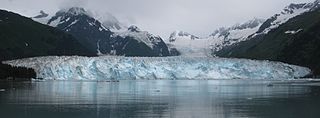 W
WThe Meares Glacier is a large and only tidewater glacier at the head of Unakwik Inlet in Chugach National Forest, Alaska. The glacier is one of the many in Prince William Sound, and is about 79.6 miles (128 km) east of Anchorage. The glacier is named for eighteenth century British naval captain John Meares. The face of the glacier is one mile (1.6 km) wide where it calves into the inlet. The glacier is sometimes visited by cruises from Valdez. Meares Glacier is currently advancing.
 W
WMiles Glacier is a 30 miles (48 km)-long glacier in the U.S. state of Alaska. It flows west to its terminus at Miles Lake, 2 miles (3.2 km) north of Goat Mountain and 33 miles (53 km) north of Katalla. It was named in 1885 after U.S. Army Maj. Gen. Nelson A. Miles by a Lt. Allen during his Alaska expedition.
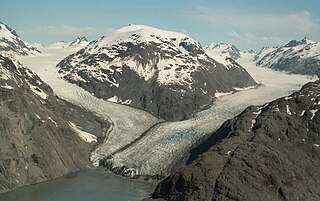 W
WMuir Glacier is a glacier in Glacier Bay National Park and Preserve in the U.S. state of Alaska. It is currently about 0.7 km (0.43 mi) wide at the terminus. As recently as the mid-1980s the glacier was a tidewater glacier and calved icebergs from a wall of ice 90 m (200 feet) tall.
 W
WMuldrow Glacier, also known as McKinley Glacier, is a large glacier in Denali National Park and Preserve in the U.S. state of Alaska. The glacier originates from the Great Icefall of Harper Glacier on the east side of Denali. The glacier moves generally eastwards, receiving Traleika Glacier and Brooks Glacier as tributaries, then turning north to emerge from the Alaska Range as the source of the McKinley River. Muldrow Glacier was named by Alfred Hulse Brooks in 1902 in honor of U.S. Geological Survey topographer Robert Muldrow. Native names include Henteel No' Loo' and Henteel No' Loot.
 W
WNabesna Glacier is a glacier in the U.S. state of Alaska. Fed by deep snowfall in the Wrangell Mountains, the 53 mile (85 km) long Nabesna is the longest valley glacier in North America and the world's longest interior valley glacier.
 W
WPenny Royal Glacier is a hanging alpine glacier in the Talkeetna Mountains of Alaska.
 W
WReid Glacier is an 11-mile-long (18 km) glacier in the U.S. state of Alaska. It trends north to Reid Inlet in Glacier Bay National Park and Preserve, two miles (3 km) south of Glacier Bay and 72 miles (116 km) northwest of Hoonah. It was named by members of the Harriman Alaska Expedition for Harry Fielding Reid.
 W
WRiggs Glacier is a glacier in Glacier Bay National Park and Preserve in the U.S. state of Alaska. It begins on the southern slope of the Takhinsha Mountains, 6 km (4 mi) southeast of Mount Harris and flows south-southeast to the head of Muir Inlet, 69 km (43 mi) southwest of Skagway.
 W
WRuth Glacier is a glacier in Denali National Park and Preserve in the U.S. state of Alaska. Its upper reaches are approximately 3 vertical miles below the summit of Denali. The glacier's "Great Gorge" is one mile wide, and drops almost 2,000 feet over 10 miles, with crevasses along the surface. Above the surface on both sides are 4,900-foot granite cliffs. From the top of the cliffs to the bottom of the glacier is a height exceeding that of the Grand Canyon. Ruth Glacier moves at a rate of three feet per day and was measured to be 4,000 feet thick in 1983.
 W
WTracy Arm is a fjord in Alaska near Juneau. It is named after the Secretary of the Navy Benjamin Franklin Tracy. It is located about 45 miles (72 km) south of Juneau and 70 miles (110 km) north of Petersburg, Alaska, off of Holkham Bay and adjacent to Stephens Passage within the Tongass National Forest. Tracy Arm is the heart of the Tracy Arm-Fords Terror Wilderness, designated by the United States Congress in 1990
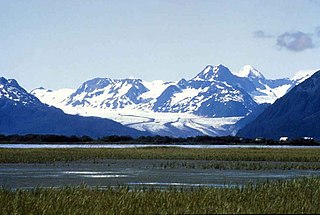 W
WScott Glacier is a 15-mile-long (24 km) glacier located in the Chugach Mountains, near Cordova, Alaska. It begins at 60°44′31″N 145°04′20″W and trends southwest to 60°37′11″N 145°23′09″W, 13 miles (21 km) east northeast of Cordova. The Scott Glacier was named in 1908 after a "local miner".
 W
WThe Stikine Icecap is a large icefield straddled on the Alaska–British Columbia boundary in the Alaska Panhandle region. It lies in the Boundary Ranges of the Coast Mountains. Within the United States, most of it is under the administration of the Tongass National Forest and is part of the Stikine-LeConte Wilderness within the national forest.
 W
WSusitna Glacier is an alpine or valley glacier in the Alaska Range. Susitna Glacier flows over a seismically active area. The 7.9-magnitude 2002 Denali earthquake struck the region in November 2002. The earthquake initiated with thrust movement on the previously unrecognized Susitna Glacier fault.
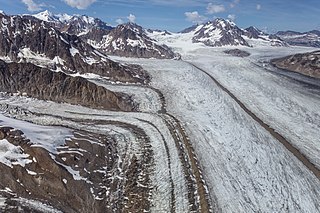 W
WTana Glacier is a 17-mile-long (27 km) glacier in the U.S. state of Alaska. It begins at Bagley Icefield and flows northwest to its 1950 terminus near the head of the Tana River. Its name, of Alaska Native origin, was first recorded by prospectors in 1900. The warmest month is August, at -2 ° C, and the coldest month is January, at -20 ° C.
 W
WTazlina Glacier is a 25-mile-long (40 km) glacier in the U.S. state of Alaska. It begins 1.5 miles (2.4 km) north of Mount Cashman and flows north to its terminus one mile (1.6 km) south of Tazlina Lake and 43 miles (69 km) north of Valdez. Tazlina Glacier is the largest northward flowing glacier in the Chugach Mountains. The terminus of the glacier is retreating and thinning. Tazlina is the largest north-flowing glacier in the Chugach Mountains. The glacier is around the Valdez area and is also a popular attraction for tourists. At the foot of the glacier lies the Tazlina Lake and the Tazlina River.
 W
WTokositna Glacier is a glacier in the Alaska Range of Denali National Park and Preserve in the U.S. state of Alaska. The glacier originates in two major arms on the east side of Mount Hunter, moving east until the main arms join, then turning south. Tokositna Glacier is the source of the Tokositna River. Spelling variants and alternate names include Tokasitna Glacier, Tokichitna Glacier and Tuqashitnu Li'a.
 W
WTraleika Glacier is a glacier in Denali National Park and Preserve in the U.S. state of Alaska. The glacier originates from two forks on either side of Farthing Horn on the east side of Denali. The west fork of the glacier starts in the Thayer Basin to the south of Denali, moving northeast and falling from the basin's 15,000-foot (4,600 m) height via the Traleika Icefall into the west fork between Karsten Ridge and the Farthing Horn. The main fork starts from Denali's east buttress in Traleika Col, joining the West Fork between the Farthing Horn and Mount Silverthrone, then moving northeast to join Muldrow Glacier. Traleika Glacier was named in 1945 by Bradford Washburn, attributing the name to a Susitna name meaning "great one" or "high one.". The form Traleika is an Anglicization of the Dena'ina name Dghelaay Ka'a, denoting Denali.
 W
WThe Tustumena Glacier is a glacier located on the Kenai Peninsula of Alaska. The Tustumena Glacier begins in the Harding Icefield and makes its way down west for about 20 miles (32 km) until its terminus roughly 5 miles (8.0 km) before Tustumena Lake. The glacier is retreating due to global warming.
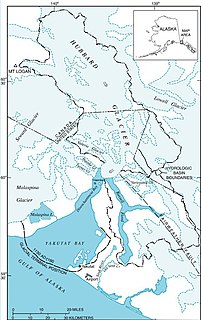 W
WVariegated Glacier is one of several glaciers which connect to Russell Fjord in Alaska. Variegated Glacier has been of considerable scientific interest because it surges every 20 years.
 W
WVassar Glacier is a 4.3-mile (6.9 km) long glacier in the U.S. state of Alaska. It trends southeast to College Fjord, 2 mi (3.2 km) west of College Point and 52 mi (84 km) west of Valdez. It was named for Vassar College in Poughkeepsie, New York, by members of the 1899 Harriman Alaska Expedition.
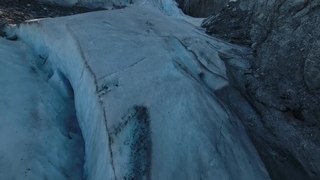 W
WThe Worthington Glacier is a 5,774-acre (2,337 ha) valley glacier located adjacent to Thompson Pass in the southeastern mainland section of the U.S. state of Alaska. Located on the Richardson Highway at milepost 28.7 mi (46 km) east of Valdez, it was listed as a National Natural Landmark in 1968. The Worthington Glacier State Recreation Site, a 113-acre (0.46 km2) roadside park operated by the state of Alaska, offers a view of the glacier, and it is acclaimed as one of the remaining U.S. glaciers that is accessible by paved highway. Like most of Alaska's glaciers, this glacier has been steadily retreating for the last 150 years, but not as dramatically as many others.
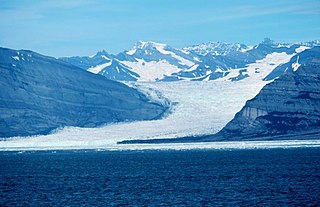 W
WYahtse Glacier is a 40-mile-long (64 km) glacier in the U.S. state of Alaska. It begins on the southeast slope of Mount Miller and trends southeast along the north border of Guyot Glacier to Icy Bay, just east of Guyot Hills and 70 miles (113 km) northwest of Yakutat. The western extent is an icefield. The name derives from the Yahtse River and was adopted after the retreat of Guyot Glacier resulted in a separate branch.
 W
WThe Yakutat Glacier is a glacier in the Brabazon Range of southeastern Alaska. It is one of the fastest moving glaciers in the world, and has been retreating since Little Ice Age. Approximate elevation 1,010 feet.